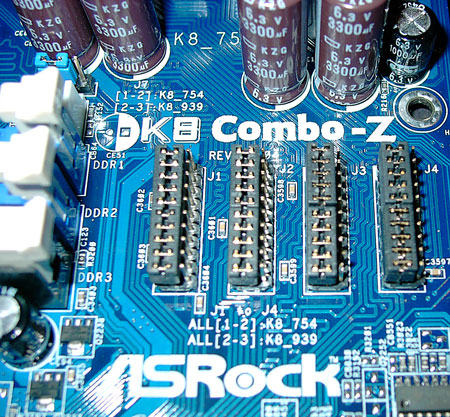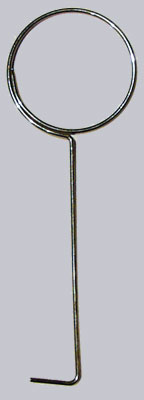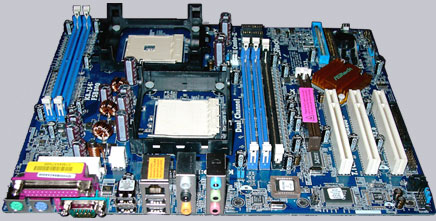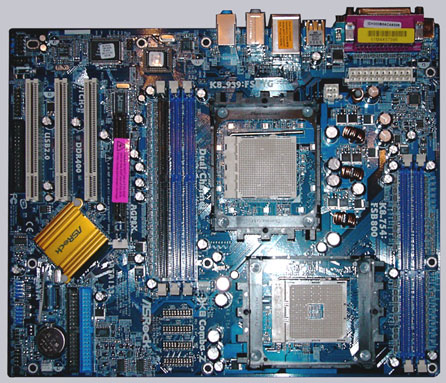
Result and general impression
+++ The ASRock K8 Combo-Z motherboard cost at present a price of approx. 60 euro (08/2005), which is really amazing, since even the most favorable Socket 754 or Socket 939 boards can be found only very rare in this price region. This board concerns besides not a conventional Socket 754/939 motherboard, but this board unites both processor variants on only one motherboard. Who is thus not sure whether he/she is to buy a favorable socket 754 processor at present, has to transfer hereby the option openly without motherboard exchange to a socket 939 system. The way of a single Channel socket 754 to a Dual Channel memory suited socket 939 system is separated with the Combo-Z only by some Jumper rows:

Thus we can get one of these two processors running within a few minutes. And thus the way becomes still somewhat simpler, provides ASRock this small tool for removing the Jumper. Simply put it into one jumper row represented above and pull it relatively pleasantly:

I faced Combo motherboards so far always somewhat sceptically, since often different generations were combined by CPUs, memory, etc. at the expense of the performance, but in this case I was instructed a better one. Because both performance of the socket 754 part and of the socket 939 part can be measured with other Socket 754/939 motherboards and is owing to the ULi chipset really acceptable.
But how does it look with possible upgrading and with the board features ? ASRock did not save money here, because on this Full size ATX board there’re 2x IDE connectors for up to 4x ATA 133 harddisks, 2x SATA ports, 4 x ATX panel USB 2.0 ports, onBoard 10/100 RTL 8201 BL LAN and 6 connectors for 7.1 Surround sound. All drivers for Windows XP and older operating systems are provided naturally on CDROM and offered at any time up-to-date with ASRock
for Download. Since depending upon used CPU also the memory banks must be changed, however the expandableness of the memory comes for the Socket 754 in the single Channel mode with 2 banks somewhat briefly (Dual Channel is technically only available at the S939 part). In socket 939 processor mode it can be used in the Dual Channel mode both 2 one-sided ones and 2 double-sided modules and in the single Channel mode the Combo board offers place for up to 3 DIMMs with altogether 2 GB memory.
Since the board has an AMI BIOS, the BIOS can be reached with the F2 key after switching on. There expect us extensive options for the timing of the memory modules, adjustable multiplicator (as usual technically causes only lower than the original multi selectable), alterable host frequency of 140 MHz up to 300 MHz and HT from 200 to 1000 MHz is selectable. Regarding a high overclocking of the system the voltage change came too briefly somewhat, since the CPU voltage can be only changed. Besides the AGP and pci bus frequency unfortunately can not be adjusted to a fixed value. But ASRock wanted to bring certainly no OC board with this Combo on the market, but rather an inexpensive multi-talent. Nevertheless I couldn’t deny myself the overclocking attempts and wanted at least an examination of the maximally possible host frequency, which still stable ran up to approx. 250 MHz. The passive cooled ULi M1689 chipset remained here also without active fan relatively cool, thus a few hundred MHz can get out from its processor. Who blow the overclocking out of all proportions, shouldn’t rely too much to the “Boot failure guard” of the BIOS, since this unfortunately likewise strikes with to high host frequency. Here will only help the CLEAR CMOS Jumper, with which the BIOS is completely set to default.
Conclusion: ASRock developed an extremely favorable Motherboard with the K8 Combo-Z, with which the choice between the inexpensive Socket 754 and the Socket 939 processor must not be final, since it’s possible to change the Athlon 64 Socket at any time within a few minutes. In point of overclocking is the otherwise very versatile Motherboard surely not the last word, but you also doesn’t run away crying 😉 Anyhow the company ASRock has reached the target of free Athlon 64 processor choice without special adapters. There was no suffer in the performance where the equipment and board layout have well positions in spite of the two sockets – well done !
Special thanks to ASRock
for their support.
**** All Socket 754 motherboard tests since 01.08.2004 are based on an AMD Athlon 64 3200+ and Socket 939 reviews are based on an AMD Athlon 64 3000+ Venice with a HIS Excalibur Radeon 9600 Pro videocard, Kingmax 256 MB PC2700 memory module and the following software configuration: Windows 98 SE, DirectX 9b, Catalyst 3.6 graphic driver and 3DMark 2003. Since all benchmark results should only offer a comparison among themselves, I select Win 98 SE for a faster OS installation which is of course not the usual OS for Athlon 64 systems but enough for a comparison.



